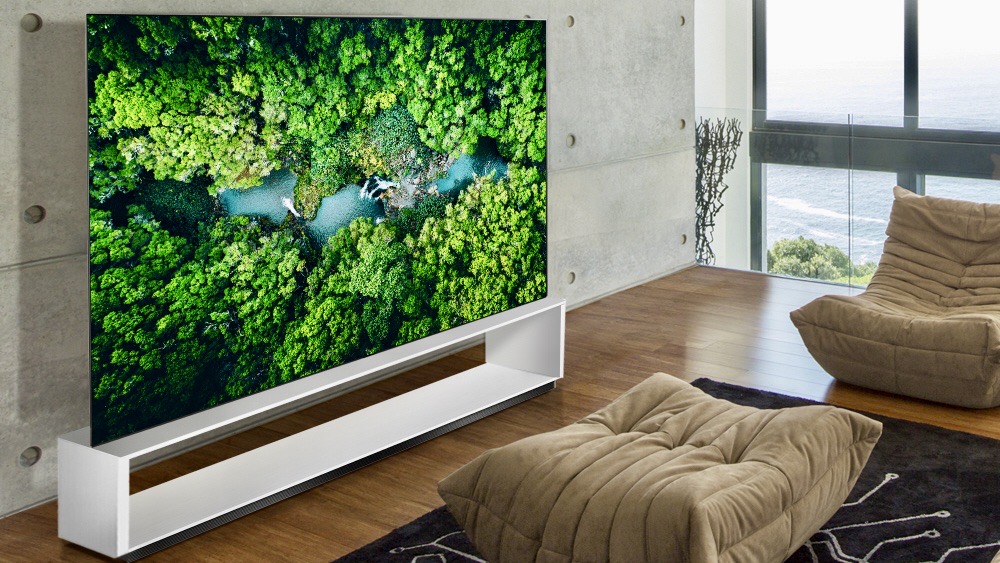
TV tech is getting a major upgrade in 2020, and we’re not just talking about a leap in resolution from 4K to 8K. Although that resolution bump is heralded as a mighty good reason to upgrade by some home cinema evangelists, I'm just as excited about the adoption of Deep Learning and innovative audio ideas.
Samsung and LG are the first to unveil such bright ideas at this week’s CES 2020 tech extravaganza in Las Vegas. I’ve had some sneak peeks at what’s coming to a high street near you, and it’s darn whizzy.
So exactly how does the big screen you’ll want to buy this year, trump that model you lusted over last summer? Read on for T3's guide to the new TV technologies that are being unveiled at CES 2020 and coming to a TV near you very soon…
8K resolution: there’s devil in the detail

If you haven’t upgraded your trusty 1080p HD gogglebox yet, then maybe it’s time to consider leapfrogging 4K UHD altogether? After some hit or miss early 8K panels, it looks like TV makers are finally getting to grips with advanced next-gen displays.
To quickly recap: Just as 4K TVs moved us from 1920 x1080 HD to 3840 x 2160 UHD, offering four times the pixel resolution, 8K screens ramp up resolution to 7680 x 4320 pixels. This is quadruple the resolution of Ultra HD, with a stonking 33 million pixels per panel.
The upshot of this improvement in image density is that TV can go much larger and you can sit much closer without worrying about seeing any pixel grid structure. Indeed, you simply have to get closer if you want to see the benefits of native 8K resolution.
The catch, of course, is that there’s next to nothing available in native 8K – and there’s not a great deal on the horizon, unless you’re optimistic about the graphical potential of the Xbox Series X and PlayStation 5 consoles. This is where smart upscaling comes in. 2020 promises a revolution in terms of picture processing, thanks to the big science of Deep Learning…
Get all the latest news, reviews, deals and buying guides on gorgeous tech, home and active products from the T3 experts
AI Enhanced Deep Learning upscaling: picture quality is getting smarter

Artificial intelligence might not take over the world in 2020, but it will make your Blu-rays look better. Samsung is souping-up AI upscaling, with neural network Deep Learning. Appearing on its incoming 8K fleet, Samsung promises the new tech will make HD and 4K content look as detailed and nuanced as native 8K.
Deep Learning improves textures and perceived detail, because it can solve processing problems that are too complicated for Machine Learning, by working slower and thinking harder. This means its good at enhanced texture creation, noise reduction and edge restoration.
This new AI processing approach, coupled with Samsung’s latest generation Quantum processing SoC, will debut in Samsung’s Q800T 8K TV models, and go all the way up to its top-of-the-line Q950TS set.
Not to be outdone, LG is also employing Deep Learning on its own 8K 2020 TVs. The company is implementing it within its new Alpha 9 Gen 3 AI image processor, to create greater image depth.
The new Alpha 9 Gen 3 processor also uses an AI Picture Pro algorithm which LG claims to be capable of recognising faces and text on screen, fine-tuning and sharpening each individually. These new sets are also smart enough to work out what you’re watching, using Auto Genre Selection recognition. Expect this impressive picture arsenal to be deployed first in its 2020 75- and 88-inch 8k Nanocell models (the Nano99, Nano97 and Nano95).
Better colour and even brighter HDR
Samsung TVs lead the way when it comes to unfettered dynamic range, but for 2020 it has developed a new approach to HDR that works on both its 4K and 8K TVs, and allows for even better contrast.
This hasn’t been achieved by just making the screens brighter; more its engineers have managed to boost HDR peak brightness on full array backlit 4K and 8K screens by adopting a new approach to power management. The result is a 20 per cent improvement in specular highlight brightness. Good news if you mainly watch HDR content in a room with high levels of ambient light.
Bye bye, bezels
Just when you thought TV design couldn’t get any more minimalist, they strip it back even more. Expect to hear a lot about Samsung’s ‘Zero Bezel’ Infinity design over the coming months. As an example of advanced panel engineering it’s rather remarkable. The new Q950T 8K QLED flagship is almost all screen, as Samsung has been able to get the bezel down to just 2mm – rendering it all but invisible at a normal viewing distance. This has a dramatic effect on images, which appear to simply hang in space.
Samsung is really showcasing its manufacturing chops here and other brands are certain to follow – Sony in particular is a master of zen design.
The war against mumbling
It’s not just images which are getting an AI upgrade this year; sound is, too. Samsung’s Q950TS TV may be wafer thin with that Zero Bezel, but it still manages to harbour a 4.2.2 speaker configuration, with discrete drivers top, bottom and on the sides. The brand’s higher-end screens will also boast a natty trick called Symphonic Sound. When coupled with a matching 2020 Samsung soundbar, both the ‘bar and screen can work together to deliver an immersive Dolby Atmos listening experience. The result is a towering wall of sound.
LG also has something clever up its sleeve when it comes to audio. An AI Sound Pro function analyses audio content in real time, classifying it as either music, movies, sports, drama or news. It then applies filters to better suit the source, as appropriate. To improve dialogue intelligibility spoken words are isolated and their volume increased, while background noises are mixed to create virtual 5.1 surround.
For over 25 years, Steve has been casting his keen eyes and ears over the best that the world of TV and audio has to offer. He was the creator of Home Cinema Choice magazine, and contributes to huge range of technology, home and music titles along with T3, including TechRadar, Louder, Ideal Home, the i newspaper, and more.

